Your friendly neighborhood record store clerk hitting the "random collection item" button on Discogs and writing about it.
Don't wanna be here? Send us removal request.
Text
Stanley Clarke, Al Di Meola, Jean-Luc Ponty - The Rite Of Strings
https://www.discogs.com/release/853788-Stanley-Clarke-Al-Di-Meola-Jean-Luc-Ponty-The-Rite-Of-Strings
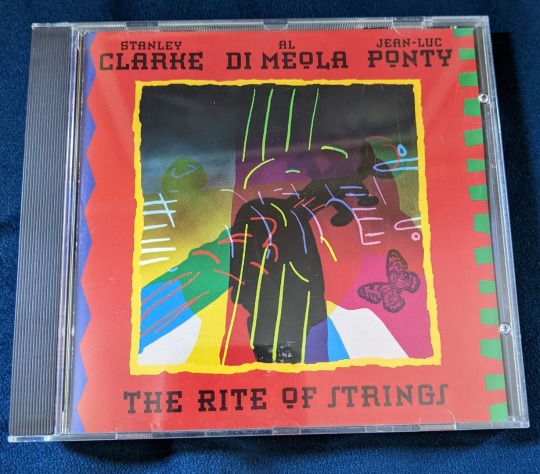
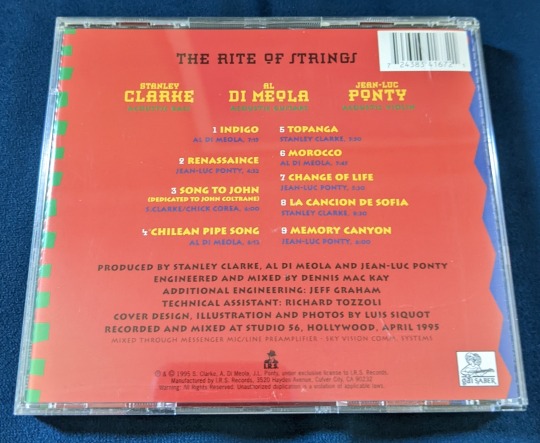
The 90s were a strange, rough time for jazz, particularly 70s fusion luminaries like the trio of Clarke, Di Meola, and Ponty assembled here. Those familiar with the genre will know Stanley Clarke and Al Di Meola from Chick Corea's groundbreaking jazz-rock fusion group Return to Forever, and Jean-Luc Ponty from John McLaughlin's equally groundbreaking jazz-rock fusion group Mahavishnu Orchestra (or, for the less jazz-inclined, his work in the years prior with Frank Zappa's also-equally-groundbreaking avant garde art rock group, The Mothers of Invention).
By the 90s all three players had enjoyed long and successful solo careers, but things were slowing down substantially for the genre as a whole. The 80s saw jazz reach its highest level of mainstream appeal since the glory days of the 50s and 60s with smooth jazz and lighter synth-laden jazz fusion gaining major traction with non-jazz listeners. At the same time, those accessible and soft-edged sounds and styles alienated more serious jazz fans. The rise and fall of mainstream 80s jazz sounds led to serious disinterest in new jazz releases in the 90s, both from jazz enthusiasts, who were disillusioned by the smooth sounds of the 80s, and from the mainstream listeners, who had almost completely moved on as harder-edged grunge and alternative rock dominated the radio waves and made the synthy adventures of the 80s feel instantly passé. This led to a number of embarrassing outings from more trend-focused jazz artists trying to recapture the attention they found in the 80s. Many others found themselves returning back to basics, with many of the jazz elite releasing more straight ahead albums in an attempt to recapture the hearts of more serious jazz listeners.
Thankfully for us, this album falls mostly in the latter category. It follows in the steps of Al Di Meola's highly successful Guitar Trio recordings with John McLaughlin and Paco de Lucia (the final of which would be recorded the following year, the prior two having been recorded in the early 80s), as a simple acoustic trio recording with a focus on great compositions and highly technical performances. I'll note that while the credits only list acoustic instrumentation, Al does sneak in a touch of guitar synth; which, in his defense, is a much more restrained amount than many of his solo records of the era. Most tracks also double Al's guitar, splitting rhythm and lead to the left and right channels. While this may be his slightly inflated ego at work (not that I can blame him, my ego would be slightly inflated if I could play like that too 🙂), it serves the tracks well and fills the large sonic space between the bass and violin out nicely.
The album clocks in at 55:34, spanning 9 tracks. Writing credits are split evenly to three tracks per player, with the sole (partial) exception being Stanley Clarke's Song to John, which was co-written with Chick Corea for Clarke's 1975 album Journey to Love. Sonically, Rite of Strings is incredibly well recorded and mixed. The imaging and soundstaging is excellent (although the soundstaging is occasionally confused by Al's overdubs, creating an odd sense of two Al clones shredding at once seated between the other two players). I'm particularly impressed with the sound of Stanley's bass; it has a very deep, resonant sound while maintaining good articulation and harmonic clarity. Often jazz recordings drop the ball on the bass, with it either sounding flubby and inarticulate or clicky and shallow. The engineers did a spectacular job of capturing the full range of the instrument while still leaving plenty of room for the remainder of the trio. Also, while I alluded to it earlier I'd like to spell it out: the compositions and performances here are truly top-notch. The players have excellent synergy, and walk the fine line between technical showmanship and performing compelling compositions in a way that serves the composition. This is a must-listen for anyone who enjoys any of the three players on the album, and is a worthy introduction to any or all of the three for those not familiar. Which brings us to the well-buried lede of this post: this album is criminally underrated. I think if this had been recorded anywhere from 10 to 20 years prior it would have received a much higher degree of notoriety. As it stands, it's one that even many jazz fans seem to be unaware of. It charted reasonably well at #4 on the contemporary jazz charts, but that was a shallow pool that few were wading in at the time. Today it seems to be mostly off the radar. The Wikipedia page is painfully sparse, and very little information is available surrounding the recording and release of the album. While I have very little reach here, I hope this inspires one or two people to check this one out.
The copy in front of me is the standard mass-market US CD release. In fact, this is almost the only release. It was released on Gai Saber, a short-lived label with only a small handful of releases from '95 & '96, with additional distribution by I.R.S. (yes, the college rock label, no, not the federal government, although either would be equally nonsensical in context). Notably both Gai Saber and I.R.S. would fold the following year in 1996; I would guess the implication of hard financial times explains I.R.S.'s baffling choice to involve themselves in this release, which is profoundly off-brand for a label better known for groups like R.E.M. and Oingo Boingo. While the CD was released in a number of markets, the different international editions appear to be identical aside from the usual differences in copyright text, etc. There was one cassette version released in the US, one promo version of the CD, and a Russian bootleg of the CD (a common occurrence at the time due to scarce music distribution across the board in most parts of the former Soviet Union). The album has never been issued on vinyl and has never been officially reissued. The booklet is a simple two page affair with all of the essentials and nothing more. The graphic design is definitely a product of its time, with a certain Old-El-Paso-meets-90s-Taco-Bell je ne sais quoi, topped off by a particularly uninteresting piece of digital abstract cover art from Luis Siquot (rightfully better known for his contributions to typesetting than for his art). Needless to say, the look of the album certainly isn't doing it any favors when it comes to attracting the attention of modern listeners. Like many long-out-of-print albums, it isn't currently available on streaming beyond some rando's YouTube upload. Luckily, the CD is very affordable used at the time of writing due to general lack of interest/awareness.
Anyways, that's all for today folks! Give this thing a listen if you can. Hoping to be able to continue posting a bit more frequently now. Til next time, may your bass be full in the mix and may your labels stay afloat.
#album review#random collection item#discogs#jazz#jazz fusion#CD#Stanley Clarke#Al Di Meola#Jean-Luc Ponty#The Rite Of Strings#out of print#now spinning
3 notes
·
View notes
Text
Weather Report - Night Passage
https://www.discogs.com/release/11535112-Weather-Report-Night-Passage

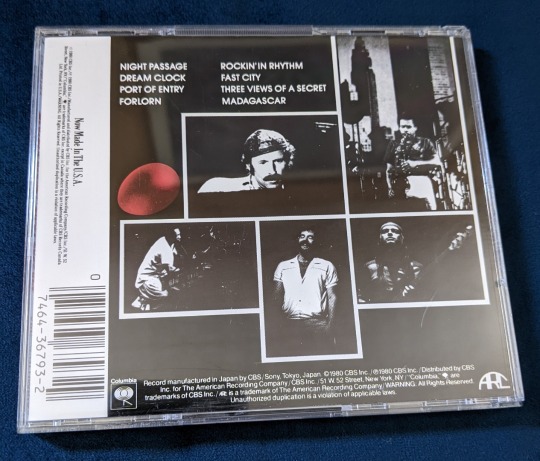
That was a bit of a longer hiatus than I'd wanted, but I'm glad to be back... and what stranger note to be back on than Weather Report's meandering first step into the 80s, Night Passage? If anyone ever accuses me of cherry picking albums for clout on this blog, posts like this will remain my ironclad defense. There's not much cool about Weather Report (unless you're a bassist, which is inherently uncool), and there's certainly nothing cool about 80s Weather Report. That being said, I'm a huge sucker for jazz fusion, and a big Weather Report fan, so let's dig in.
Weather Report has a strange history. The core of the band, and only two reasonably consistent members, are the legendary Wayne Shorter and Joe Zawinul. Shorter and Zawinul formed the group after their time together in Miles Davis' band, where they helped gestate the beginning of his controversial (but, in my humble opinion, excellent) electric era on the In A Silent Way and Bitches Brew sessions. (Before some nerd corrects me: Wayne, of course, was in Miles' band well before Joe as part of the second great quintet). Early Weather Report was on the more improvisational and experimental end of fusion, then found a fascination with world music, followed by a transition into more accessible synth-laden tunes as Zawinul began to take more and more of the role of sole band leader as opposed to the original co-leader configuration with Shorter. As anyone with marginal familiarity with the genre knows, Weather Report struck gold in 1977 with the release of Heavy Weather and its hit single Birdland. Heavy Weather sold half a million copies, a truly staggering feat for a jazz fusion album, rocketing the band to the closest thing to stardom a jazz musician can expect (short of Miles Davis himself, or perhaps Kenny G if you want to broach the controversial topic of whether or not he counts as "real jazz").
Night Passage finds the band at a turning point. Their previous two releases (Mr. Gone, and the live album 8:30) had failed to find the critical or commercial success of Heavy Weather. Wayne Shorter was becoming increasingly uninvolved, as evidenced by his single songwriting credit on the album compared to Joe Zawinul's five (incidentally, Shorter's tune Port of Entry is one of highlights of the album). Jaco Pastorious had already launched into a successful solo career and was beginning to find crossover success of his own following a number of years playing with Joni Mitchell. Consumer tastes and music technology were changing rapidly, turning towards digital production and catchy, synth laden pop tunes, with significantly decreased interest in the meandering double albums and 10+ minute songs of the 70s. The band had brought on a secondary percussionist, Robert Thomas Jr, presumably to shake things up a bit and to bring back a sound more reminiscent of their earlier output.
Night Passage falls in an interesting spot in their discography, serving as a link between the Weather Report of the 70s and the Weather Report of the 80s. It, in many ways, feels like the last "true" Weather Report album. Its self-titled successor (not to be confused with their self-titled debut album) was the last to feature Jaco Pastorious and Peter Erskine and found all members except Zawinul sonically and compositionally alienated, muffled and overwhelmed by his vision and "synthesized big band" compositional approach. Night Passage, while anticipating that sound, manages to still maintain a sense of musical unity and group participation that their later discography is sorely lacking.
Compositionally, Night Passage is hit-or-miss. Jaco and Wayne each contributed a single composition (Three Views of a Secret and the aforementioned Port of Entry respectively), both of which are highlights. They also play a smokin' version of the classic Ellington tune, Rockin' in Rhythm; while all the band members had become fairly far-removed from straight-ahead jazz stylistically, it's a good reminder that all of them come from the top of that world and can play the hell out of a jazz standard. Zawinul's compositions are spottier, and often feel like they're part of a different album entirely.
Sonically, the album is technically well-recorded but feels a bit flat and lifeless. While the documentation I can find claims this album was recorded in analog, it has a sonic signature that I associate more with the primitive days of digital recording in the early 80s. I suspect that The Complex in LA (where all tracks except the final live track were recorded) were taking advantage of some "cutting edge" digital studio pieces in the earlier stages of the signal chain. Columbia was still pumping some good money into the production at this stage with the hopes of producing another Heavy Weather.
If you've never listened to Weather Report, this probably isn't your place to start (I recommend the classic Heavy Weather, or I Sing The Body Electric if you're more inclined towards experimental sounds). But if you're a fan who's written off their 80s output entirely without listening, this one is the most worthy of your time and attention in the era, showing glimpses of a very different future than the one we got.
The copy in front of me is a fairly standard US-made mass-market CD issue. The reissue year isn't discernable from the runout info and barcode, but I would guess late 80s or early 90s based on the packaging. The sound is solid, and as mentioned previously, likely held back more by the source material than the quality of the release itself. While I don't have an original to compare it to, this copy doesn't appear to be remastered and is likely identical to the original CD issue. The booklet is a basic one-sided four-panel foldout "road map style" affair, copied and lightly reformatted directly from the original LP sleeve. Seeing as I likely paid no more than $4 used for the disc (likely a fraction of that), I'm certainly not going to complain. My only other note on the physical release is that, for some reason, Joe Zawinul decided to rebrand himself simply as Zawinul in the credits, while the rest of the band members maintain their full names. He's hip with the kids, one might say.
And with that I think we can put a pin in it, a bow on it, and, if you play your cards right, maybe even a cherry on top of it. Til next time, may your transitional albums take you to greener grass and may your synth orchestration stay tasteful. Hoping to be back with more much, much sooner than before 🙂
#album review#discogs#random collection item#jazz#now spinning#CD#jazz fusion#Weather Report#Night Passage
1 note
·
View note
Text
Quick Update
Hey all! Thanks for all the love on the Clipping review, it means a lot. Had to take an unplanned posting break on account of overtime season at work smoothly transitioning into getting the good ol' Modelovirus (on week three of the damn thing right now and still feeling it), and on top of it my partner just lost her job five days before Christmas 🙂🙂🙂. Oh and my antique hot water heater might be about to die in the middle of winter. Yee and/or haw. Anyways I'm sure y'all aren't here to listen to me bitch about my life, just wanted to explain the radio silence and let you know I'm alive. Hopefully will be back up and running in the next couple weeks barring any other major disasters.
Oh yeah, Scaring The Hoes is AOTY btw, no contest. Enjoy the holiday if you celebrate and I'll see you on the flip side ❤️
0 notes
Text
clipping. - Face
https://www.discogs.com/release/11980126-Clipping-Face
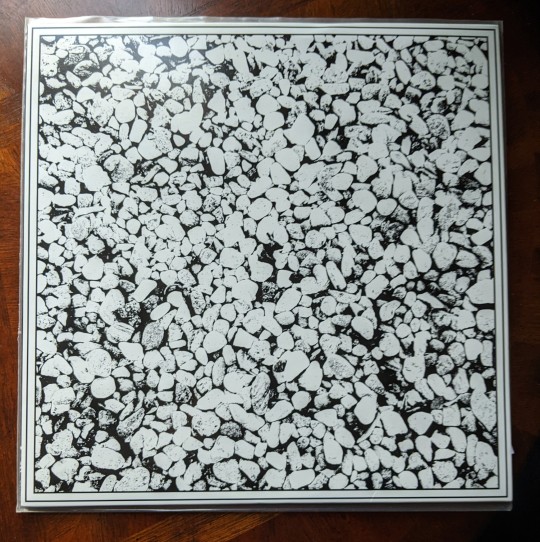

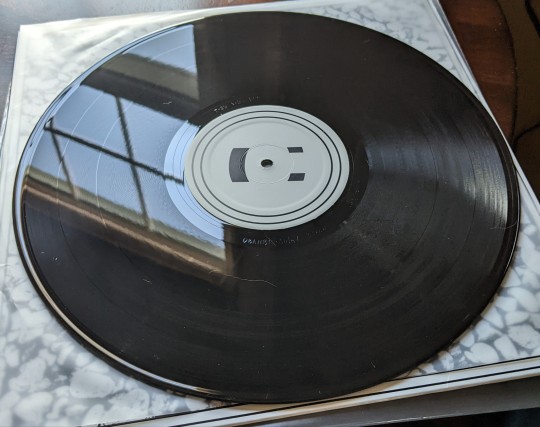
Hey, we finally had a record show up! This is the 2018 vinyl reissue of the 2012 debut EP from beloved industrial rap trio Clipping (they stylize it as "clipping." but it fucks up my formatting mojo so I'm sticking to the capital C for this one). The A side is the original 3 track tape, and the B side is remixes and an acapella. This version was released by Deathbomb Arc, the same label that put out the original EP.
I was a little late to the Clipping party and got on board with them shortly after the release of their semi-self-titled debut album, CLPPNG. CLPPNG dropped right after Death Grips broke up and the hype surrounding Clipping on the internet was mostly /mu/ posters heralding them as The Next Death Grips. I always thought that comparison was questionable. Outside of a vague sense of being in the same genre they don't share a lot of DNA, with Clipping pulling heavily from harsh noise and power electronics in contrast to Death Grips' sample-heavy sound fueled by math rock-adjacent live drums. Regardless, the JENNY DEATH WHEN era hype train brought Clipping in front of a relatively big audience of outsider rap nerds looking for another hit of bizarre sounds, and they brought it in spades. After listening to CLPPNG an embarrassing number of times I worked my way back to midcity (their first mixtape) and Face. Face really stuck with me, so I was thrilled to see it reissued in 2018 and picked it up immediately.
The original EP is a short-but-sweet three song affair that wastes no space and takes no prisoners. The opening track, the eponymous Face, is a blistering assault of lighting fast bars, blasts of noise, and a catchy x-rated chorus. It's followed by Studio Freestyle 01, which serves as a sort of mental breather in the middle of the list (as much of one as Clipping will give you at least), with mid-tempo freestyle verses alternating call-and-response style with bursts of harsh noise. The EP rounds out with Block, my personal favorite track from the project. Block showcases Daveed Diggs' uncanny ability to make even the smallest things seem profound and significant. A song about nothing becomes a song about everything as he paints a picture of a city block on top of a slow-burning beat. There are no characters. There is no action and no narrative. And that's the beauty of it.
The B side is a collection of remixes backed with an acapella of the first track. I'm normally not a huge fan of remixes, but the selection here is a fun listen. The first two are remixes of the title track, with the first turning it into a stompy industrial club tune and the second chopping it into a wall of samples (including a shockingly straight-faced interpolation of Gangnam Style, and a slightly less straight-faced interlude of the intro to Never Gonna Give You Up). This is followed by Clipping's remix of This Song Is A Drug Deal, by LA noise rock drum-and-shout group Foot Village. It chops up the spastic drums from the original song and uses them as a bed for some verses from Daveed. The side closes out with the acapella of Face, not exactly critical listening but I'm glad it's out there for DJs and remix artists to take advantage of.
As previously mentioned, the copy in front of me is the 2018 Deathbomb Arc vinyl issue, the only vinyl issue to date. The 2012 original pressing was only on cassette, and this deluxe reissue was also available on cassette with an expanded tracklist containing additional Face remixes. I opted for the vinyl version because, frankly, I lived through tapes the first time around; they sucked then, they suck now, and part of me withers away every time I have to buy a new one. Regardless, the vinyl edition is simple but well-presented. The album art still looks good when blown up to 12"x12", and they did a nice job typesetting the back cover. It includes a download code for the download-inclined, and opts for a polybag rather than a paper inner (I breathe a sigh of relief every time I open a new record and don't need to immediately resleeve the LP, records are too damn expensive now for these labels to cheap out with the crappy paper inners that shed everywhere and scuff your new record up). The pressing is fairly shallow, but my copy plays well with little to no surface noise. The sound is a bit dull, but it's not exactly a hi-fi recording in the first place so I'm not going to complain. No inserts or liner notes on this one, but an EP doesn't really need all that anyways. Overall I think they've done a nice job with the reissue.
I think the beauty of Face is that it paints a fairly complete picture of Clipping in only 3 tracks. You have the high energy sonic assaults, you have the artsy contemplation, and you have the fearless harsh noise and power electronics interludes. While it's not their most essential work, if you want a short elevator pitch for why you should care about Clipping, this is it. A great start to a legendary career. Rest assured, if I keep doing this long enough we'll see plenty of other Clipping releases in the future, so strap in for some more noise rap greatness down the road. In the meantime, may your music stay pleasantly abrasive and may your preferred genitals be in your face.
#album review#discogs#random collection item#face#clipping.#industrial hip hop#noise rap#vinyl#LP#deathbomb arc#clipping#now spinning
19 notes
·
View notes
Text
Chick Corea And Béla Fleck - The Enchantment
https://www.discogs.com/release/1446687-Chick-Corea-And-B%C3%A9la-Fleck-The-Enchantment
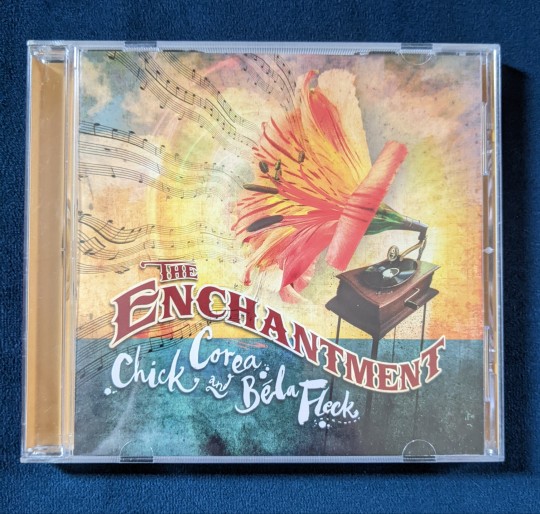
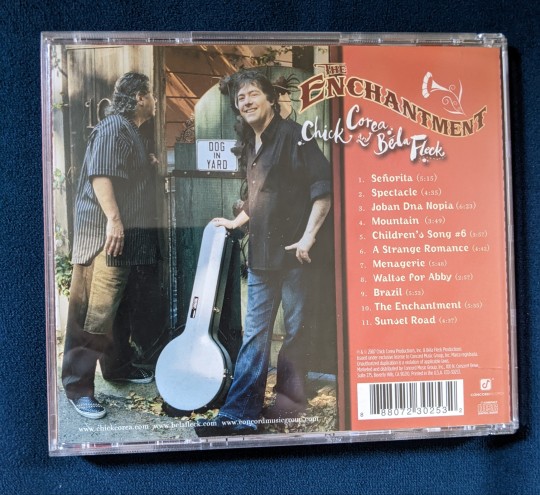
Please join me in mourning here at the funeral for my internet music nerd cool points, because I'm about to talk about how I like this album.
The Enchantment is a 2007 collaborative album between two relatively polarizing artists in the world of jazz: Chick Corea (a virtuoso pianist best known by most for his synth-tastic 70s and 80s jazz fusion with groups like Return to Forever and his Elektric Band) and Béla Fleck (a virtuoso banjo player best known for putting slap bass together with electric banjo shredding in the 90s with his group The Flecktones). They're both solidly in the "love it or hate it" world of music. Chick and Béla both came originally from the more traditional end of their genres (jazz and bluegrass respectively) and both leapt wholeheartedly into the world of weird and generally uncool music. As an ardent jazz fusion apologist I'm naturally a huge Chick Corea fan. I also love his more avant-garde recordings, and his more straight ahead jazz. As for Béla Fleck, I've always been more partial to his acoustic work, both his early bluegrass recordings and his more out-there modern acoustic recordings.
So where does The Enchantment lie? It's all-acoustic, which by 2007 was starting to become the norm again for both players and continues to be my preference for Béla's work, and features no additional players and no overdubs. Musically, I'd say it's jazz-adjacent. The general writing style feels very reminiscent of Chick's writing on My Spanish Heart and much of his other Spanish-influenced 70s work, despite Béla having the majority of the writing credits on the album (6 to Chick's 4, with the 11th credit going to Ary Barroso for their use of his classic 1939 tune Brazil). Interestingly it also won a Latin Grammy for Best Instrumental Album, which was not on my bingo card for things that would come up on this blog but apparently should have been.
An instrumental piano & banjo duo album feels like a dangerous sort of record to try and make, especially with the goal of the album being to feel like a true duo recording rather than an accompanist & soloist arrangement. I think it's testament to the profound level of skill and experience of both players that this record sounds like anything more than a mess. While the playing is virtuosic and frequently quite busy, it's very clear that both players are really listening to and engaging with each other. I don't like to get on my high horse about listening to music ~as a musician~ (whatever that really means), but this is an album where that sort of musical synchronicity and mutual respect really sticks out to me in a way that may be less apparent to non-musicians, who may focus more on the speed and precision of many of these parts. On a related note, I particularly love the unison lines on this album. It's fascinating to me how they can both play the same thing at the same time and blend while also still sounding radically like themselves and often quite different from each other, with Chick's playing taking a more fluid, flourishing style and Béla tending more towards very tight and precise lines. You can tell there's a deep level of listening happening between the players, and it's a pleasure to hear.
Similarly, I'm really impressed by the mix on this album. While it may not immediately jump out, I can tell you from experience that this is not an easy sort of combo to mix. Piano has an extremely large sound that dominates the frequency band (particularly with a player like Chick, who tends to play wide across multiple octaves), whereas banjo has a small, clicky sound, very narrowly focused on a much smaller band of highs and high mids. It's tough to balance those in a way that sounds both even and natural, and I think Bernie Kirsch did a great job. I'm sure the legendary mastering expertise of Bernie Grundman (a double Bernie event!) helped here too.
The copy in front of me is the original 2007 US CD release on Concord. The album has never been issued on vinyl, and has never been reissued outside of a 2021 Japan-only SHM-CD release (a running theme you'll see on here with many jazz albums). The liner notes are simple but effective, with clear credits, a centerfold photo of the recording session, and some Special Thanks (including a shout-out to L. Ron Hubbard, who was also not on my bingo card for this blog but should come as no surprise since Chick was a devout Scientologist from the 70s on through the rest of his life). The graphic design and presentation of the whole thing is pretty ugly in that classic 00s way. And honestly I don't know that it looked great at the time either, but I guess Creed did mad numbers back then so what do I know? Regardless, the wacky carnival font and goofy digital collage on the front cover are sure to turn most modern listeners off right from the start. I can't imagine someone who isn't already a fan of one or both artists ever picking this up from the rack and giving it a shot.
That being said, those that do pick it up are in for a treat. There's a lot of great playing and songwriting on this, and while I doubt it would make a top 10 list for either artist involved I think that's more of a testament to the significance and reach of their careers rather than a slight against the album itself. If you like either or both artists I highly recommend giving this one a listen. If you're not familiar with them this may not be the most informative starting point, but it's certainly not a bad one. This is also an excellent listen for anyone who plays an instrument; there's a lot to learn here about top-level interplay and listening. Check it out if that sounds like your sort of thing. And until next time, may your graphic design stay tasteful and may your playing stay tasty.
#album review#chick corea#béla fleck#jazz#jazz fusion#latin jazz#The Enchantment#Concord Records#discogs#random collection item
0 notes
Text
Nils Petter Molvær - Khmer
https://www.discogs.com/release/4816629-Nils-Petter-Molv%C3%A6r-Khmer
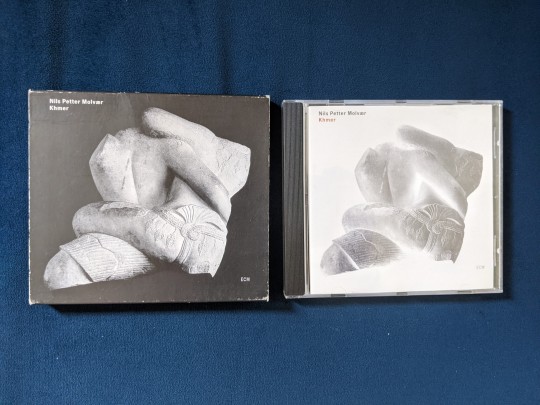

Welp, it was only a matter of time before the wacky jazz cuts started to come out of the woodwork. This one comes to us from Norwegian trumpeter Nils Petter Molvær by way of eclectic jazz and classical label ECM (which I'm sure will make many more appearances on here as time goes on).
Khmer, released in 1997, was a touchstone in the burgeoning genre of future jazz (aka nu jazz), which saw jazz artists flirting with ideas from the worlds of electronic, dance, and hip-hop. You can find earlier incarnations of these ideas in Miles Davis' 80s output (which, as maligned as it was at the time, continues to inform some of the trendier jazz styles of the last 20 years), as well as many of Bill Laswell's various projects and collaborations. Future jazz would go on to peak in the early 2000s with artists like Herbie Hancock jumping on board and very successful (by jazz-adjacent standards) releases from artists like St Germain.
As you might imagine, most future jazz feels (somewhat ironically) aesthetically and stylistically mired in time in the late 90s/early 00s. I think Khmer does a better job than most of feeling a little less dated. While some of the drum loops show their age, tracks like Platonic Years feel like they could have been released last week. Khmer seems less interested in pretensions of getting club play and more in threading those ideas into larger soundscapes. Many future jazz releases feel like they're desperately trying to reach a younger, trendier crowd, whereas Khmer seems to be bringing some newer (again, relative to the time) ideas to ECM's listener base of more open-minded jazz fans. Molvær's playing is tastefully sparse and intentional, often adding little aside from the occasional melody line to a track (again reminding me of Miles' later output, although Molvær's style is much softer and eschews the heavy funk influences Miles had in that era). The rest of the players follow a similar schema, with very little traditional soloing and more of a focus on creating a cohesive musical story.
The copy in front of me is the regular mass-market 1997 German CD release, sporting ECM's signature cardboard slipcase (which, like most, is looking worse for wear 26 years later). ECM had abandoned vinyl at the time, so Khmer would go on to be CD-only until its 2019 LP issue. It also has received a few limited Japan-only releases on SHM-CD and HQCD. ECM has always adhered to strictly minimalist design philosophies, and this release is no exception. The liner notes are simple but informative; no exposition or interviews, just the facts. The rest of the packaging follows suit.
As is the standard at ECM, Khmer is impeccably recorded, mixed, and mastered. It's refreshing for this style in particular, as many of the other releases I've heard in the genre have shot for more of a highly compressed club sound. Khmer maintains wide dynamics while still keeping the bass deep and the drum loops punchy.
Overall, Khmer is a fun listen. I wouldn't describe it as particularly essential outside of its niche in a brief moment in jazz's history, but it's well worth checking out. It's interesting enough for focused listening, but inoffensive and vibey enough to fade into the background if needed. It's also a pleasantly accessible listen for non-jazz listeners, while still being reasonably recognizable as a form of jazz (something that definitely can't be said for every future jazz release). Give it a spin sometime if that sounds like your type of thing. Until next time, may your drum loops stay well-sequenced and may your ligatures stay well-connected.
0 notes
Text
Cirith Ungol - King Of The Dead
https://www.discogs.com/release/10276929-Cirith-Ungol-King-Of-The-Dead
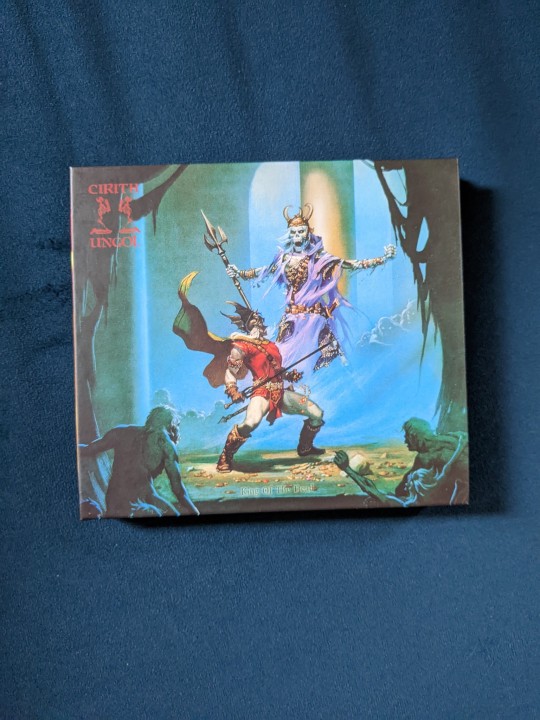
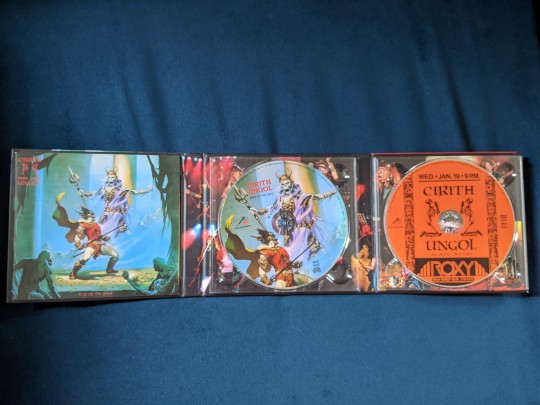
Man, I couldn't have asked for a better pick to start things off. If you have any interest at all in classic heavy metal, stop what you're doing and listen to Cirith Ungol. If you don't have any interest in classic heavy metal, stop what you're doing and listen to Cirith Ungol anyways. King of the Dead has it all: heavy riffs, tight leather pants, Michael Whelan art ripped straight off a Moorcock novel, Lord of the Rings references... what more could you want?
Cirith Ungol is one of those strange bands like The Scorpions that hustled all through the 70s but didn't really make a name for themselves until the 80s. Despite forming in '71 their first album didn't release until a decade later, followed up by King of the Dead in 1984. King of the Dead moves away from the proto-power-metal sounds of their debut and focuses in on slower Sabbathian riffs. There's a common argument floating around that King of the Dead is the first doom metal album, and while I'm not much of one to get mired in online debates about metal subgenres I will say that the title track makes a damn good argument for that classification. As a bassist myself, I'll also note that this album has some of the tastiest bass playing in heavy metal. Their bassist, simply known as Flint, takes the front stage of many tracks with punchy Rickenbacker tones and busy, melodic bass parts.
The copy I have here is the 2017 deluxe CD reissue on Metal Blade. They've done a nice job with this edition. I'm a known hater of the digipack but they picked one that's a bit heavier duty than most and has held up well, still looking fairly new 6 years later. The booklet includes track-by-track interviews with band members, a few collages of scanned-in ephemera, classic photos of the band, lyrics, and a good page of credits and recording info (often undervalued but infinitely useful for collectors/dorks like myself). This reissue features newly remastered audio, attempting to bring it back closer to the sound of the original 1984 Enigma release per the aforementioned helpful liner notes. I don't have an original LP or the '99 Metal Blade CD to compare to, but this one sounds pretty good for its age and fairly low budget (with the original recording being self-produced by the band). The ever-helpful dr.loudness-war.info provides an average dynamic range score of 10 for our version (pretty solid for the age and genre) with the '99 reissue clocking in at an 8 (for the socially well-adjusted people who don't obsess over this stuff: a higher DR number means loud parts are louder and quiet parts are quieter, evidence of less use of wideband compression during the mastering process and typically resulting in a more "musical" sound overall; google "loudness war" for more info on what this is and why it matters). The CD follows the main album up with a live cut from '84, a rare compilation track, and a few live tracks from the band's 2016 reunion. Nothing essential, but a nice selection of bonus material.
This edition comes with a live DVD of the band at The Roxy shortly before the album's release (recorded on 1/19/83 for those keeping score at home), preserved in authentic 1980s blur-o-vision. The DVD audio sounds like it was taken from the VHS tape rather than the soundboard, with the bass and kick drum often blowing out the rest of the mix. Overall it's a pretty rough watch, cool to see but I doubt I'll revisit it. I did enjoy watching their roadie cheesin next to the guitar amp the whole time, dude's just happy to be here. Same buddy, same.
I'm sure it's obvious at this point, but I absolutely adore this album. Cirith Ungol has soundtracked a hell of a lot of sessions of my old AD&D game and a hell of a lot of hours on the road back when I used to drive around putting up show flyers for a living. I don't plan to do numerical ratings on this blog, but I do give this a wholehearted endorsement for anyone looking to bring some classic 80s cheese into their life. Until next time, may your hair stay long and may your heavy metal Bach interpolations stay as tight as your pants.
#album review#cirith ungol#king of the dead#heavy metal#metal#metal blade records#discogs#random collection item
0 notes